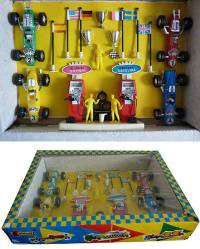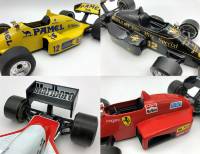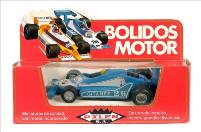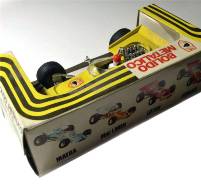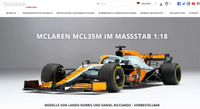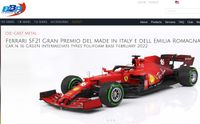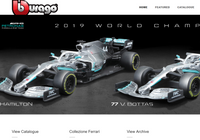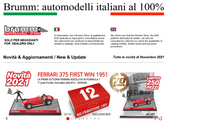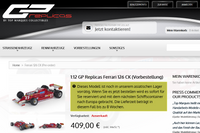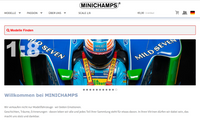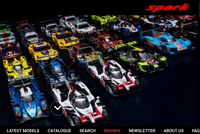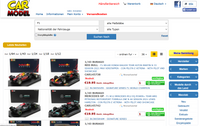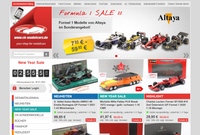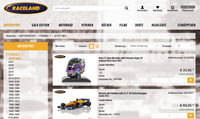Manufacturers from Spain
Guisval
Guisval was founded in Ibi close to Alicante where other toy manufacturers come from too. The name of the company is derived from its founders: Francisco Guillém (GUI), José Luis Serralta (S) and Ramón Valero (VAL). The first modelcars appeared in 1962. It was a series of four Formula One plastic racer. The set was named «Bólidos Competición» and was marked with the item number 3000. The four cars were reduced to 1:34 – a pretty rare size. But that was not the only unusual thing: All models had a metallic look – far from reality. The set consisted of a Vanwall, a Cooper 1500 cm3, a Gordini Type 32 and a Cooper Norton which raced in Formula Junior. The models were sold separately or as a set. Like Schuco the Spanish company produced also a construction set in which the cars had to be assembled first. In 1968 four other Formula One models without engine cover came out. they were sold in blister packs. Like their predecessors they were also made out of plastic. Although they are all different the «cavalino rampante», the trademark of Ferrari, has been put on each side of the four cars. What kind of models Guisval wanted to represent with these toy racing cars is not quite clear.
«Because they are not of good quality
only a few collectors consider them
as real collecting objects.» f1modelcars.com
Guisval generally didn't care much about original painting and sponsorship. Another example is the series released from 1968 with models from Ferrari, Lola, Brabham and Lotus in 1:66. These models are poor. With stickers and colors which did not exist in reality. At least the numbering of the models is funny: Instead of a number the models bear names of different racetracks – from Albi to Spa-Francorchamps. The twelve different models look very similar to the one from Penny. However the Spanish racers have never reached that quality. If you buy a Guisval miniature from the «racetrack series» in the original acrylic box today you have to remove the model carefully because in many cases the adhesive on tires and rims is fused with the plastic-packaging. In 1981 Guisval produced another Formula One car: the white and blue Brabham BMW BT49 in 1:55. In the late nineties a series in the same scale followed – with Ferrari 640, McLaren-Honda MP4/5, Benetton-Ford B189, Lotus-Judd 101, Williams-Renault FW16, Jordan-Peugeot 197 and McLaren-Mercedes MP4/13. The models are not ugly. But typical for Guisval with stickers which didn't exist. The prices of Formula One models made by Guisval are generally not very high. Only nicely conserved sets are rare. Like the set «Bólidos Competición» which I already saw once for 300 Euro. The 1:66 and 1:55 models on the other hand can be found easily. Because they are not of good quality only a few collectors consider them as real collecting objects. Official site: www.guisval.com
Guisval stammt aus der Spielzeughochburg Ibi und stellt seit 1962 Modellautos her. Der Name des Unternehmens wurde von den Anfangsbuchstaben der drei Gründer abgeleitet: Francisco Guillém (GUI), José Luis Serralta (S) and Ramón Valero (VAL). Die ersten Gehversuche unternahmen die Spanier mit einer Serie von vier Formel-1-Nachbildungen aus Plastik. Das Set trug den Namen «Bólidos Competición» und war mit der Artikelnummer 3000 gekennzeichnet. Das Quartett wurde um das 34fache verkleinert – ein aussergewöhnlicher Massstab. Noch aussergewöhnlicher waren die Lackierungen. Alle Modelle hatten einen metallischen Glanz – weit weg von der Realität. Das Set bestand aus einem Vanwall, einem Cooper 1500 cm3, einem Gordini Type 32 und einem Cooper Norton, wobei Letzterer nie an der Formel-1-WM teilgenommen hatte. Die Modelle waren auch einzeln im Verkauf erhältlich. Und wie bei Schuco gab es von den vier Racern ein Konstruktions-Set, bei dem die Modelle zuerst zusammengesetzt werden mussten. 1968 erschienen vier weitere F1-Modelle ohne Motorhaube in Blister-Verpackungen. Wie ihre Vorgänger waren auch sie aus Plastik. Obwohl sie alle unterschiedlich sind, prangt auf jedem seitlich das «cavalino rampante», das Wahrzeichen Ferraris. Welche Modelle Guisval mit den vier Spielzeug-Rennern darstellen wollte, ist nicht eindeutig klar.
«Weil die Qualität zu wünschen übrig lässt,
nehmen nur wenige Sammler Guisval-Modelle
als echte Sammelobjekte wahr.» f1modelcars.com
Guisval scheint im Allgemeinen nicht viel Wert auf originale Lackierungen und Sponsorenaufschriften gelegt zu haben. Auch bei der ab 1968 erschienenen 1:66er-Reihe mit Modellen von Ferrari, Lola, Brabham und Lotus herrscht farbliches Chaos. Witzig ist allein die Nummerierung der Modelle: Statt einer Zahl tragen die Modelle Namen verschiedener Rennstrecken – von Albi bis Spa-Francorchamps. Guisval hat die Serie wie viele andere Modellautohersteller bei Politoys abgekupfert. Allerdings sind die Spanier punkto Qualität nie an die Penny-Modelle der Italiener herangekommen. Wer heute eine Guisval-Miniatur aus der «Rennstrecken-Serie» in der originalen Acryl-Box ersteht, muss das Modell in der Regel sorgfältig aus der Verpackung lösen, weil der Kleber an Reifen und Felgen bei vielen Modellen mit dem Plastik verschmolzen ist. 1981 meldete sich Guisval bei Formel-1-Fans mit dem weiss-blauen Brabham-BMW BT49 in 1:55 zurück. In den späten Neunzigern folgte eine Serie im selben Massstab mit Ferrari 640, McLaren-Honda MP4/5, Benetton-Ford B189, Lotus-Judd 101, Williams-Renault FW16, Jordan-Peugeot 197 und McLaren-Mercedes MP4/13. Auch hier setzt es ungenügende Noten für nicht originale Lackierung und Aufkleber. Die Preise von F1-Modellen made by Guisval sind unterschiedlich. Gut erhaltene Sets sind rar. Das Set mit dem Namen «Bólidos Competición» habe ich schon für 300 Euro gesehen. Die 1:66er- und 1:55er-Verkleinerungen dagegen findet man oft. Ausserdem sind sie von nicht sehr guter Qualität, sodass nur wenige Sammler sie als echte Sammelobjekte wahrnehmen. Offizielle Seite: www.guisval.com
Inzaplas
There is hardly no other manufacturer on whose range of models I know less than Inzaplas (Industrias del Zamak y Plásticos). My information is based on the indication of the packaging. It says that the company from Zaragoza produced six Formula One models in total. I have only seen two of them until now: a Ferrari 312 T2 (No. 404) and a Renault RS01 (No. 405) – both in 1:32. The four others are: a Brabham BT49 (No. 401), a Williams FW07B (No. 402), a Lotus 78 (No. 403) and a Matra (No. 406). The latter probably should be a Ligier-Matra JS7 (or JS9). I am not sure if these four models (half die-cast, half plastic) have ever gone into production. Inzaplas is not mentioned in «Modelcars Made in Spain», one of the most reliable reference on Spanish model manufacturers by Paolo Rampini. Whereas the Renault is okay there are some strange sponsorship logos on the Ferrari. Such as Dunlop or Martini. The shape of the models reminds me very much of slot car racers from the late seventies made by Polistil. In addition to the Formula One models Inzaplas has also produced some sports- and rally-cars as well as classic cars – part of it in 1:24. There is not much to say about the value of the Inzaplas models. In the last 40 years I have found exactly these two copies – for a very reasonable prize.
Es gibt kaum ein Unternehmen, über deren Modellpalette ich weniger in Erfahrung bringen kann als Inzaplas (Industrias del Zamak y Plásticos). Meine Informationen beschränken sich größtenteils auf die Verpackungsangaben. Dort steht, dass das Unternehmen aus dem spanischen Saragossa neben dem Ferrari 312 T2 (Nr. 404) und dem Renault RS01 (Nr. 405) noch vier weitere F1-Miniaturen in 1:32 hergestellt haben soll. Dazu zählen der Brabham BT49 (Nr. 401), der Williams FW07B (Nr. 402), der Lotus 78 (Nr. 403) und ein Matra (Nr. 406), wobei damit wahrscheinlich der Ligier-Matra JS7 (oder JS9) gemeint ist. Ob diese vier Modelle (halb Zinkdruckguss, halb Kunststoff) jemals in Produktion gegangen sind, entzieht sich meiner Kenntnis. In «Modelcars Made in Spain», einem der verlässlichsten Nachschlagewerke über spanische Modellautohersteller von Paolo Rampini, wird Inzaplas jedenfalls nicht erwähnt. Während der Renault einen ordentlichen Eindruck hinterlässt, ist der Ferrari vor allem in Sachen Sponsoraufschriften kein Vorbild. Die Spanier haben den Renner von Niki Lauda versehntlich mit Dunlop- und Martini-Schriftzügen ins Rennen geschickt. Die Form der Modelle erinnert an Slot-Car-Racer von Polistil aus den späten Siebzigerjahren. Neben der Formel 1 hat Inzaplas auch Sportwagen-, Rallye- und Oldtimer-Modelle hergestellt. Einen Teil davon auch in 1:24. Über den Wert der Inzaplas-Modelle gibt es nicht viel zu sagen. In den letzten 40 Jahren habe ich genau diese beiden Exemplare gefunden – zu einem sehr vernünftigen Preis.
Mira
Mira is the only Spanish die cast manufacturer having reduced Formula One cars to a scale of 1:25. Eight models have been released by the company from Ibi (Alicante). The first miniature, a Brabham-BMW BT54 from Nelson Piquet, appeared around 1987/88. It was followed by the Ferrari 156 driven by Michele Alboreto and the McLaren-TAG Porsche from Alain Prost. The series was extended around 1990 with a Benetton-Ford of 1987, a Williams-Honda as well as a black and yellow Lotus. At the end of the Eighties the Spaniards initially ignored the ban of tobacco-advertising. While the 1:24 models made by Italian manufacturer Bburago never «smoked» Mira put logos of Marlboro on its Ferrari and McLaren. Even the black Lotus driven by Ayrton Senna got some original tobacco branding – at least in a first attempt. Later the lettering disappeared and were replaced by «John Mira Special». The yellow Lotus 99T with the active suspension which Ayrton Senna drove to victory in Monte Carlo and Detroit 1987 was released with «Pamel» instead of «Camel». By the way: Both Lotus and the Benetton models are identical. The Formula One die casts made by Mira couldn’t compete with the Bburagos from the «Grand Prix» series which was quite popular at the same time. Not only because the steering was missing, the Miras are much more clumsy. Especially if you look at the wheels and the suspensions. But the thing which bothered me always the most are the mirrors. Bburago was well advised not to put some on their own models. Mira models have not experienced a great increase in value. I wouldn’t pay more than 20 Euro. With two expectations: First there is a set with four cars which is quite rare. Second watch out for the models with tobacco advertising. They could get interesting.
Mira ist der einzige spanische Die-Cast-Hersteller, der Formel-1-Autos im Maßstab 1:25 verkleinerte. Acht Modelle nach F1-Vorbildern sind bei den Modellbauern aus Ibi (Alicante) erschienen. Die erste F1-Miniatur, ein Brabham-BMW BT54 von Nelson Piquet, tauchte um 1987/88 im Spielwarenhandel auf. Es folgten der Ferrari 156 von Michele Alboreto und der McLaren-TAG-Porsche von Alain Prost. Die Serie wurde um 1990 mit einem Benetton-Ford von 1987, einem Williams-Honda sowie einem schwarzen und gelben Lotus erweitert. Das gegen Ende der Achtzigerjahre eingeführte Tabakwerbeverbot auf Modellautos haben die Spanier anfangs ignoriert. Während die 1:24er-Modelle von Marktleader Bburago nie «rauchten», prangen auf dem Ferrari und dem McLaren von Mira Schriftzüge von Marlboro. Auch auf einer ersten Serie des schwarzen 86er-Lotus von Ayrton Senna sollen noch originale Tabakschriftzüge abgedruckt worden sein. Mit der Zeit verschwanden diese und wurden durch «John Mira Special» ersetzt. Der gelbe Lotus 99T mit der aktiven Radaufhängung, den Ayrton Senna 1987 zu Siegen in Monte Carlo und Detroit pilotierte, warb bei Mira von Anfang an mit «Pamel» statt «Camel». Beide Lotus sowie die Benetton-Modelle sind im übrigen identisch. Die Formel-1-Modelle der Spanier konnten es qualitativ nicht mit den Bburagos aus der «Grand-Prix»-Serie aufnehmen. Es fehlt nicht nur die Lenkung; die Räder und die Aufhängungen wirken viel klobiger als bei der weit verbreiteten Konkurrenz aus Italien. Besonders befremdend wirken die Rückspiegel. Auf die hatte Bburago aus gutem Grund verzichtet. Einen großen Wertzuwachs haben die Mira-Modelle nicht erfahren. An Börsen und im Internet werden selten über 20 Euro pro Modell geboten. Gesucht sind höchstens das Viererset und die Modelle mit Tabakwerbung. Letztere könnten im Preis steigen.
Pilen
Pilen is also an exciting Spanish model car manufacturer. Besides Guisval which still exists today perhaps the most famous. Pilen entered the market in the beginning of the seventies with a series of ten Grand Prix miniatures. The 1:43 models are very similar to the Penny modelcars of Politoys which appeared in 1:60. If you study the Pilen catalogue carefully, you can see that these are actually replicas. The top row – from the Eagle F1 to the Honda V12 – shows original Pilen models. The vehicles pictured below were not ready at the time the catalogue went into production. So one took some pictures of the Penny miniatures. That can be seen not only on the numbers but also on the rims. The series in 1:43 included the following cars: Eagle, Cooper-Maserati, Honda V12, Ferrari 36V and F1, BRM H16 and V8, Lola-Climax, Lotus Climax and Brabham. In copying the Penny-models Pilen even went so far to produce a set of five models – like Penny did a few years earlier. The lovely set is today regarded as rarity and a veritable eye-catcher compared to the usual acrylic packaging which doesn't look very nice. At one point the Pilen models were also available in chrome finishes. These models should appeal to the younger customers in particular. Suspensions, exhaust pipes, etc. were made of plastic. Whereas the rest of the model was made in die-cast. At the beginning of the eighties the company from Ibi near Alicante released another Formula One series. This time in 1:55. It included the Brabham BT48, the Lotus 78 (which was sold as Wolf WR7 John Player), the Lotus 80, the Wolf WR7, the Ferrari 312T4, the Ligier JS11 and the McLaren M28. Pilen also copied these models in Italy (by Polistil). At the end of the eighties the Spanish toy manufacturer was taken over by the Dutch group AHC. At the beginning of the nineties bankruptcy was reported. The name Pilen disappeared. The models of the first series are priced around 20 Euro. The ones of the 1:55-series are cheaper.
Auch Pilen ist ein spannender Anbieter von Modellautos aus Spanien. Neben Guisval, die es heute noch gibt, womöglich der bekannteste. Pilen ist Anfang der Siebzigerjahre mit einer Serie aus zehn Grand-Prix-Miniaturen auf den Markt gekommen. Die 1:43er-Modelle erinnern stark an die Penny-Fahrzeuge von Politoys, die in 1:60 erschienen sind. Wer den Pilen-Katalog genau studiert, erkennt, dass es sich hier tatsächlich um Nachbildungen handelt. Die obere Reihe – vom Eagle F1 bis zum Honda V12 – zeigt Original-Pilen-Modelle. Die darunter abgebildeten Fahrzeuge waren zum Zeitpunkt, als der Katalog in Produktion ging, offenbar noch nicht fertig. Man bediente sich deshalb mit Bildern der Penny-Miniaturen, was nicht nur an den Startnummern gut zu erkennen ist, sondern auch an den Felgen. Die Serie in 1:43 umfasste folgende Fahrzeuge: Eagle, Cooper-Maserati, Honda V12, Ferrari 36V und F1, BRM H16 und V8, Lola-Climax, Lotus Climax und Brabham. Pilen ging beim Kopieren der «Pennys» sogar soweit, dass man die Modelle wie beim italienischen Vorbild in Fünfersets angeboten hat. Diese gelten heute als Rarität und sind gegenüber den üblichen Acryl-Verpackungen eine Augenweide. Ab und zu trifft man die Pilen-Modelle auch in Chromlackierung an. Diese wurden etwas später aufgelegt und sollten bei der jüngeren Kundschaft Anklang finden. Wie die Vorbilder von Penny sind die Pilen-F1 Die-Cast-Miniaturen. Aufhängungen, Auspuffrohre etc. wurden aus Plastik hergestellt. Anfang der Achtziger legte das Unternehmen aus Ibi bei Alicante eine weitere F1-Serie auf. Diesmal in 1:55. Dazu gehören der Brabham BT48, der Lotus 78 (der als Wolf WR7 John Player verkauft wurde), der Lotus 80, der Wolf WR7, der Ferrari 312T4, der Ligier JS11 und der McLaren M28. Auch diese Modelle hat Pilen in Italien (von Polistil) abgekupfert. Ende der Achtziger wurde der spanische Spielzeughersteller vom niederländischen Konzern AHC übernommen. Anfang der Neunziger meldete man Konkurs an. Pilen verschwand von der Bildfläche. Die Modelle der ersten Reihe sind heute (mint boxed) zu Preisen um die 20 Euro erhältlich. Die Polistil-Kopien gehen für gewöhnlich unter 20 Euro (pro Stück) über den Ladentisch.
Redondo
I do not know Redondo for a long time. Honestely I didn’t know the little Penny-copies from Spain before trading through Internet. And there is still not a lot to say about this Spanish company which was founded in 1949. Redondo had its mainquarter in Aldaya, a small town close to Valencia. The company was specialized in producing toys – mainly in plastic like blinking robots but also some toy-guns and -pistols made out of iron. I am pretty sure that the amount of toys they were producing was not huge. It also looks like most oft he toys they produced were sold in stores with cheap products. I also do not rule out that Redondo supplied traders which sold their products on the streets. That doesn’t mean that the Formula One models made by Redondo were cheap and worthless. They are very similar to the modelcars by Penny which were available through Politoys. As written in the Politoys-chapter Redondo copied the moulds. But compared to all others Redondo chose another numbering system. The Penny collection which was made out of 15 different models starts with number 0/1, a BRM V8. At Redondo this car was even not part of the first eight models. There it all starts with the Ferrari which is equivalent to number 4 of the Penny series. The rest of the collection was numbered as the following list shows: Nr. 1 Ferrari, Nr. 2 Honda (Nr. 10 in the Penny series), Nr. 3 Brabham Repco (11), Nr. 4 Lotus Climax (4), Nr. 5 Cooper-Maserati (6), Nr. 6 BRM H16 (8), Nr. 7 McLaren-Ford (12) und Nr. 8 Eagle Weslake (14).
Series two is even more interesting. It starts with number 9, a second Eagle. Which was also issued by Penny – as number 7. Compared to the original modelcar by Penny Redondo added a front- and rearwing to the car. But not only to the Eagle. Also number 10 to 16 are different to the Penny models due to this changes. I cannot say why Redondo changed the look of the second series. I presume that the Spaniard had knowledge of the Dutch company Efsi. There models (copies of the Bestbox models) also got a front- and a rearwing when they were reissued under the name of Efsi.
The «Los Mini Redondo» were available in different packagings. The first series was sold in tiny cardboardpackagings – similar to the ones made by Penny (Politoys). The second series was packed in small acrylboxes. Both series were also available as keychains in blisterpackagings.
At the beginning or rather in the mid-seventies Redondo issued another Formula One series. This time in 1:24. At least that’s written on the packaging. In reality I would rather describe them as 1:32. There were four different models available: Lotus-Ford 63 (Ref. 213), Matra MS80 (Ref. 214), Ferrari (Ref. 215) und McLaren M9A (Ref. 216). These models are rare. And if you find one, it is often in bad conditions with rearview mirrors missing or damaged suspensions. It is supposed that the production of Redondo lasted until 1996. What would mean that the Spaniard were almost half a century on the market. Concerning the prizes the Mini-Redondos are equal to the Penny-models. Even though they are less common. The bigger sized F1-models made by Redondo are prized between 30 and 40 Euro. But only if they are in pristine condition.
Auf Modelle von Redondo bin ich erst im fortgeschrittenen Zeitalter des Internets gestossen. Vorher waren mir die kleinen Penny-Kopien aus Spanien unbekannt. Viel ist über diese spanische Firma, die es offenbar schon seit 1949 gab, auch nicht bekannt. Der Firmensitz von Redondo war in Aldaya, einem kleinen Städtchen in der Agglomeration von Valencia. Dort stellte das Unternehmen diverses Spielzeug her – teilweise aus Plastik wie beispielsweise wild blinkende Roboter, aber auch Spielzeuggewehre oder-pistolen aus Metall. Die Vermutung liegt nahe, dass die Stückzahlen im Allgemeinen überschaubar waren. Auch macht es den Anschein, dass der Grossteil der Produktion in Läden mit vergleichsweise billigeren Produkten landete. Ich schliesse auch nicht aus, dass Redondo Händler, die ihre Ware auf der Strasse verkauft haben, beliefert hat. Als Ramsch würde ich die Formel-1-Modelle, die es von Redondo gab, deshalb aber nicht bezeichnen. Sie sind in ihrer Art verblüffend ähnlich wie die Penny-Modelle, die es von Politoys gab. Wie wir aus dem Polistil/Politoys-Kapitel wissen, sind die Spanier längst nicht die einzigen, die abgekupfert haben. Was jedoch anders ist, ist die Nummerierung. Die Penny-Kollektion, bestehend aus 15 verschiedenen Modellen, beginnt mit der 0/1, dem BRM V8. Bei Redondo taucht der BRM gar nicht unter den ersten acht Modellen auf. Dort beginnt die Serie mit dem Ferrari, der bei Penny die Nummer 4 trägt. So ergibt sich ein ganz anderes Bild als bei den Italienern. Bei Redondo sieht die Nummerierung wie folgt aus: Nr. 1 Ferrari, Nr. 2 Honda (bei Penny die Nr. 10), Nr. 3 Brabham Repco (11), Nr. 4 Lotus Climax (4), Nr. 5 Cooper-Maserati (6), Nr. 6 BRM H16 (8), Nr. 7 McLaren-Ford (12) und Nr. 8 Eagle Weslake (14).
Interessant ist vor allem die zweite Serie. Sie beginnt mit der Nummer 9, einem zweiten Eagle. Den gibt es auch bei Penny. Dort hat er die Nummer 7. Aber im Unterschied zum Original hat Redondo dem Modell einen Front- und einen Heckspoiler verpasst. Und das nicht nur beim Eagle. Auch die Modelle mit Nummer 10 bis 16 heben sich in diesen beiden Punkten von den Pennys ab. Wie man bei Redondo auf die Idee gekommen ist, die Fahrzeuge so zu verändern, entzieht sich meiner Kenntnis. Meine Vermutung geht dahin, dass die Spanier Modelle des niederländischen Herstellers Efsi in die Finger gekriegt haben. Efsi hat als Nachfolger von Bestbox deren Modelle nämlich auch mit ähnlichen Front- und Heckspoiler aufgewertet.
Die «Los Mini Redondo» gab es in verschiedenen Verpackungen. Die erste Serie – ähnlich wie Penny – habe ich bisher nur in winzigen Kartonschachteln gesehen. Die zweite Kollektion wurde in Acrylboxen gesteckt. Beide gab es auch als Schlüsselanhänger in Blisterverpackungen.
Anfang/Mitte der Siebzigerjahre hat Redondo noch eine weitere Formel-1-Serie herausgebracht. Diesmal in 1:24. So steht es zumindest auf der Verpackung. Ich würde behaupten, dass diese Modelle aber eher dem Massstab 1:32 entsprechen. Vier verschiedene Modelle gab es zur Auswahl: McLaren M9A (Ref. 216), Lotus-Ford 63 (Ref. 213), Ferrari (Ref. 215) und Matra MS80 (Ref. 214). Diese Modelle findet man nicht oft. Und wenn, dann meistens in schlechtem Zustand. Oft fehlen diesen Rennern die Rückspiegel oder die Aufhängungen sind nicht komplett. Angeblich hat Redondo noch bis 1996 Spielzeug produziert, womit die Spanier fast ein halbes Jahrhundert Geschichte geschrieben haben. Preislich liegen die Mini-Redondos auf Penny-Niveau. Obwohl sie deutlich seltener anzutreffen sind. Für die grösseren Redondo-Modelle sind Preis um die 30 bis 40 Euro angebracht. Jedoch nur bei tadellosem Zustand.
